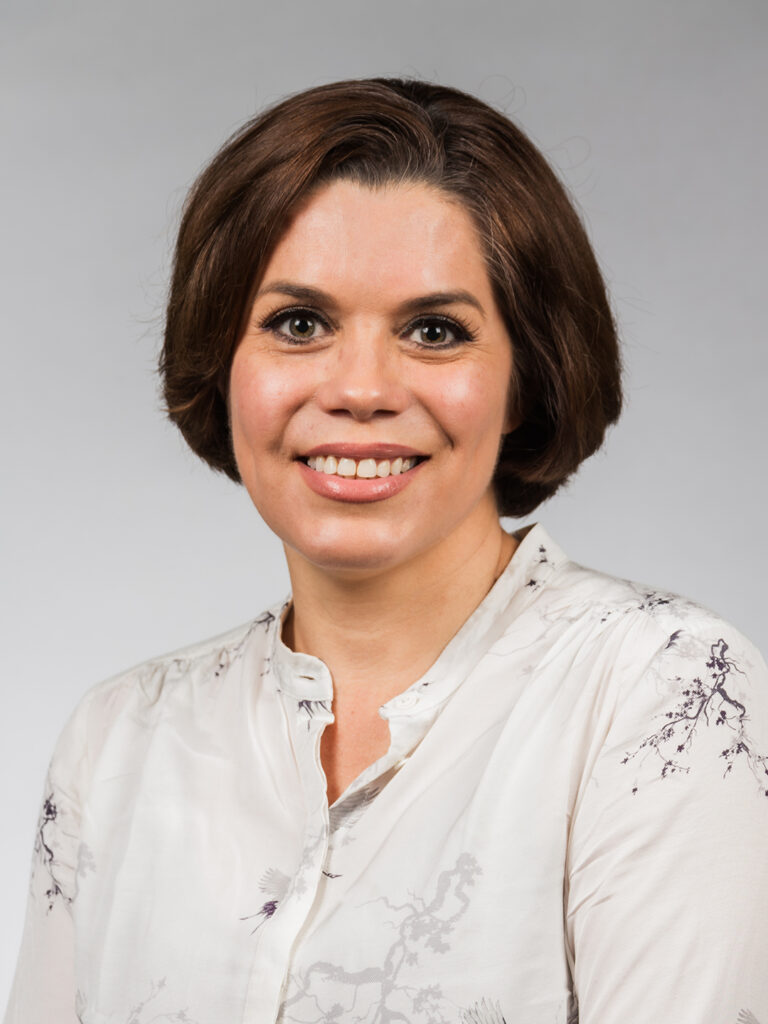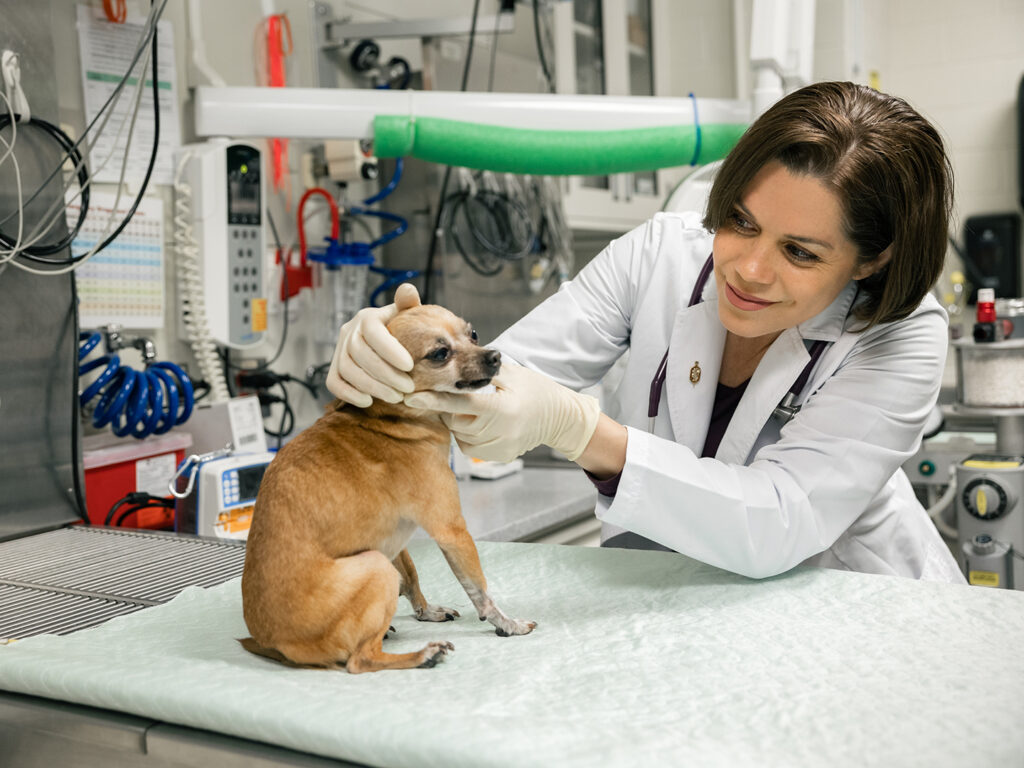Texas A&M Small Animal Teaching Hospital Welcomes New Dentist
Story by Courtney Price, VMBS Communications

As the Texas A&M Small Animal Teaching Hospital’s (SATH) newest veterinary dentist, Dr. Adriana Regalado is advancing veterinary dental techniques while educating Aggie veterinary students on the importance of caring for patients’ teeth.
Regalado joins the SATH’s Dentistry Service as a clinical assistant professor in the Texas A&M School of Veterinary Medicine & Biomedical Sciences’ (VMBS) Department of Small Animal Clinical Sciences.
She looks forward to bringing her specialized knowledge of oral surgery techniques to the SATH as well as collaborating with other university researchers to improve dental care for dogs with compressed facial structures.
Finding A Place To Belong
Teeth weren’t always Regalado’s passion; while in veterinary school at the University of Guadalajara, she had planned to specialize in shelter medicine and soft tissue surgery.
“After veterinary school, I worked in several places, including the Small Animal University Hospital in Guadalajara and at Novartis, a veterinary medicine producer. Eventually, I moved to Canada and went to the University of Guelph to learn English and work on my veterinarian board certification,” she said. “Then, in Vancouver, I worked as a technician in a local veterinary clinic, and the vet I worked for was studying to become a dentistry specialist.”
Inspired by the hands-on experience she was gaining at the clinic, Regalado decided to pursue a dentistry specialization herself.
“Dental hygiene is so important because it’s one of the main ways that infection enters the body,” she said. “If you want to protect your pet from infection and disease, you have to include protecting their teeth and gums.”
To ensure that her patients received the best care possible, Regalado continued to pursue advanced training and research opportunities in veterinary dentistry, eventually earning her board certification through the American Veterinary Dentistry Association. She also completed a private residency program in a veterinary dental speciality clinic in Vancouver.
Most recently, Regalado completed a prestigious fellowship in maxillofacial surgery at the University of Pennsylvania, which gave her experience in many advanced types of surgery, including cleft palate repair, facial fracture repair, and difficult cancer removal surgeries. She is currently completing her fellowship certification in the speciality.
It was during her time at the University of Pennsylvania that Regalado heard about the job opening Texas A&M. Though Regalado specializes in dentistry for small animals, her alma mater in Mexico has agricultural roots similar to Texas A&M, which encouraged her to consider applying.
“One of my mentors at the University of Pennsylvania pointed out the similarities between the schools and told me I would feel comfortable at Texas A&M,” she said. “I like the fact that the veterinary students are preparing for all kinds of practices, whether it’s small animal or a more agricultural focus. It helps you stay in touch with all parts of the veterinary practice.”
Advancing Veterinary Dentistry

Photo by Jason Nitsch ’14, School of Veterinary Medicine & Biomedical Sciences
As a clinician scientist — someone who treats patients and also conducts medical research — Regalado looks forward to continuing her work in several key areas of veterinary dental health at Texas A&M.
One health issue that she’s researched is a growth called papilloma that some dogs get in their mouths.
“Most of the time, these papilloma are benign, but we’re finding that some of these papilloma can transform into cancerous growths, and there is no cure,” Regalado said.
“These growths also appear to resemble similar types of growths that occur in humans,” she said. “This means that research into malignant canine papilloma may result in information or treatments that can benefit both dogs and humans.”
Regalado also is studying ways to better help diagnose and treat dental concerns in certain breeds of dogs that have shortened snouts — often referred to as brachycephalic breeds.
“Brachycephalic breeds include dogs like bulldogs, boxers and pugs that have unique face and jaw structures,” she said. “Because everything is closer together, it’s more difficult to detect certain types of dental problems, and we may have to use different techniques to treat them. To do that, we need to continue studying and documenting their facial structures.”
Finally, Regalado is also passionate about bringing atraumatic — or less invasive — tooth extraction techniques to veterinary medicine.
“Over the past 15 years, significant advancements have been made in atraumatic extraction methods in the field of human dentistry,” she explained. “However, these techniques are not widely known or utilized in the extraction of teeth in dogs and cats. My interest lies in adapting these techniques to prioritize minimal trauma to surrounding tissues, as well as to preserve bone integrity, enhance patient comfort, promote faster healing, and reduce the risk of postoperative complications in dogs and cats.”
Most exciting to Regalado is the opportunity she sees to partner with other specialists and services at Texas A&M to make these medical advancements happen.
“At Texas A&M, I see the potential to continue my studies of brachycephalic dog facial anatomy with the use of advanced imaging techniques available at the SATH,” she said. “I am also optimistic that we can develop a collaboration with the Texas A&M Department of Biomedical Engineering to make the necessary adaptations to existing extraction tools or design new instruments for atraumatic tooth extraction.”
Giving Back
Now that Regalado has joined the SATH team, she’s ready to begin helping patients and making sure that future Aggie veterinarians leave the school well-prepared to care for animals, and their smiles, all over Texas and beyond.
“I like teaching because I can share everything I know with someone else and help them learn and grow,” she said. “I can also make sure every student is engaged and knows that there are no stupid questions. I want to be there to encourage them.”
Regalado also has long-term plans to help build the SATH’s veterinary dentistry service.
“When I took this job, I knew that Texas A&M was looking for someone willing to commit to being here for many years. It’s one of the reasons I ended up coming here instead of going somewhere else. I’m hoping that while I’m here, we can start a residency program in dentistry so that more people can get the training required to become board-certified veterinary dentists,” she said.
Being able to give back to the community is one of the parts of the job that Regalado is most excited for.
“I have everything I need to be able to pay back to the community and my field,” Regalado said. “I really love getting to help animals and the families who love them, and I love serving my community by finding ways to make veterinary care more accessible. Being a veterinarian gives you so many opportunities to give back and feel like you are making a difference.”
###
For more information about the Texas A&M School of Veterinary Medicine & Biomedical Sciences, please visit our website at vetmed.tamu.edu or join us on Facebook, Instagram, and Twitter.
Contact Information: Jennifer Gauntt, Director of VMBS Communications, Texas A&M School of Veterinary Medicine & Biomedical Sciences, jgauntt@cvm.tamu.edu, 979-862-4216


